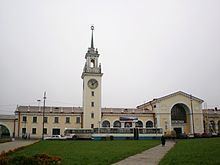Coat of arms Flag Area 108.2 km² | Administrative district Volkhovsky District Local time Wednesday 12:35 AM | |
 | ||
Settlement municipal formation Volkhovskoye Settlement Municipal Formation Administrative center of Volkhovsky District, Volkhovskoye Settlement Municipal Formation Weather 4°C, Wind S at 11 km/h, 84% Humidity Points of interest Muzey istorii g Volkhova, Pamyatnik akademiku Graftio GO, Memorial "Geroicheskim zashchitn | ||
Volkhov (Russian: Во́лхов) is an industrial town and the administrative center of Volkhovsky District in Leningrad Oblast, Russia, located on the Volkhov River 122 kilometers (76 mi) east of St. Petersburg. Population: 47,182 (2010 Census); 46,596 (2002 Census); 50,325 (1989 Census).
Contents
- Map of Volkhov Leningrad Oblast Russia
- History
- Administrative and municipal status
- Industry
- Transportation
- Culture and recreation
- Twin towns and sister cities
- References
Map of Volkhov, Leningrad Oblast, Russia
History
The town developed during the industrialization in the first half of the 20th century. The settlement of Zvanka (Званка) with a train depot was built here while the railway connecting St. Petersburg with Vologda was being constructed. It was a part of Novoladozhsky Uyezd of St. Petersburg Governorate. A second rail line running north of the station towards Murmansk was constructed in 1916, making the station an important railway junction. In 1918, construction of the Volkhov Hydroelectric Station (the first in the Soviet Union) started on this spot. In 1926, the power plant became operational and in 1932, the first Soviet aluminum plant was launched nearby.
On August 1, 1927, the uyezds were abolished and Volkhovsky District, with the administrative center in Zvanka, was established. The governorates were also abolished and the district became a part of Leningrad Okrug of Leningrad Oblast. On August 15, 1930, the okrugs were abolished as well and the districts were directly subordinated to the oblast. On December 27, 1933, the settlements serving the station, the dam, and the aluminum plant were merged with several adjacent villages to form the town of Volkhovstroy. On September 19, 1939, Volkhovstroy became a town of oblast significance and on April 11, 1940, it was renamed Volkhov. In 2010, the administrative structure of Leningrad Oblast was harmonized with its municipal structure and Volkhov became a town of district significance.
Administrative and municipal status
Within the framework of administrative divisions, Volkhov serves as the administrative center of Volkhovsky District. As an administrative division, it is incorporated within Volkhovsky District as Volkhovskoye Settlement Municipal Formation. As a municipal division, Volkhovskoye Settlement Municipal Formation is incorporated within Volkhovsky Municipal District as Volkhovskoye Urban Settlement.
Industry
The economy of Volkhov is essentially based on the Volkhov Hydroelectric Station and on the aluminum production plant.
Transportation
Volkhov (railway stations Volkhovstroy I and Volkhovstroy II) is an important railway hub. One railway line connects in with St. Petersburg (Moskovsky Rail Terminal), and Volkhovstroy I is the terminal station of suburban trains from St. Petersburg. To the east, a railway line continues to Vologda via Tikhvin and Cherepovets. Another railway line passing through Volkhov connects Chudovo in the south and Lodeynoye Pole, Petrozavodsk, and ultimately Murmansk in the north. In Chudovo, it connects to railway between St. Petersburg and Moscow, so that all traffic between Moscow and Murmansk proceeds via Volkhovstroy.
Volkhov is located on the road connecting Kiselnya on the M18 Highway, which connects St. Petersburg and Murmansk, and Tikhvin, Cherepovets and Vologda. Volkhov is also connected by roads with Kirishi and with Novaya Ladoga. There are also local roads, with bus traffic originating from Volkhov.
The Volkhov River is navigable; however, there is no passenger navigation.
Culture and recreation
The district contains five cultural heritage monuments of federal significance and additionally seventeen objects classified as cultural and historical heritage of local significance. The federal monuments are the Volkhov Hydroelectric station, the monument to Genrikh Graftio, the head of the construction of the power plant, the first building of the aluminum plant, as well as the houses where Graftio and Boris Vedeneyev, who was also leading the power plant construction, lived.
Twin towns and sister cities
Volkhov is twinned with:
